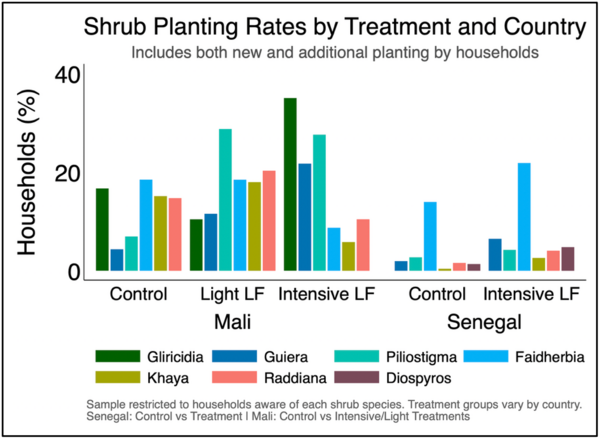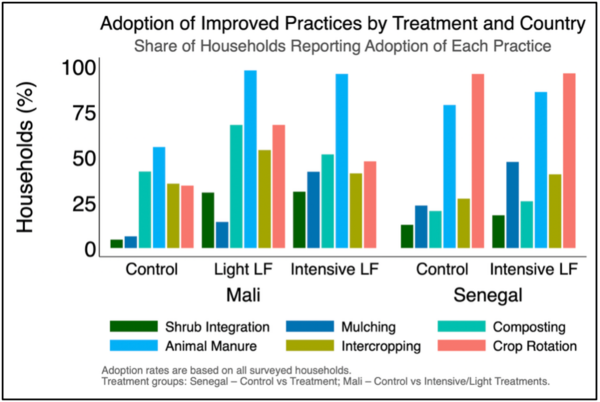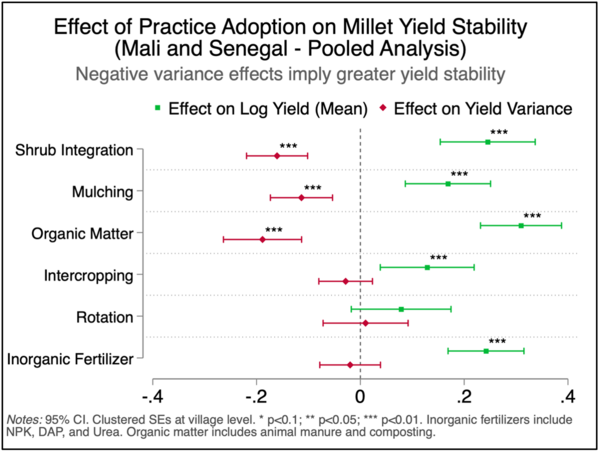A new impact study from the SustainSahel project offers robust real-world evidence that agroecological intensification—especially when anchored in nitrogen-fixing shrubs and bundled with sustainable farming practices—delivers measurable productivity and resilience benefits for smallholder farmers in the Sahel.
Based on a five-year, cluster-randomized controlled trial across 180 villages in Mali and Senegal, the study evaluates the adoption and impact of crop–shrub–livestock (CSL) systems promoted via two advisory models: a high-intensity model with in-person coaching, and a lighter-touch model leveraging multimedia tools. Both approaches aimed to foster the uptake of practices such as shrub integration, composting, mulching, and legume-based intercropping.
Agroecological uptake
The findings reveal a powerful pathway from knowledge sharing to sustained adoption and measurable yield improvement. Farmers in intervention villages significantly increased their adoption of improved practices—especially where the advisory support was more intensive. As seen in Figure 7, showing the adoption rates of shrub planting of key shrub species like Faidherbia albida, Guiera senegalensis, and Gliricidia sepium. Beyond shrub planting, the SustainSahel interventions promoted a range of sustainable agroecological intensification practices designed to improve soil fertility, nutrient recycling, and crop resilience. This included shrub integration, mulching, composting, the use of animal manure, cereal-legume intercropping and rotation. As shown in Figure 12, these practices were widely adopted in treatment areas across Mali and Senegal - adoption rates rose by up to 40% in Mali, and was similarly strong in Senegal under intensive support.
Key finding: Adoption of agroecological practices increased significantly, including shrub integration (up to 26%), mulching (up to 36%), and organic matter use (composting and animal manure - up to 40%)
Importantly, this uptake was not superficial. Farmers expressed strong motivation to continue and expand their use of agroecological innovations. However, the results also highlights persistent barriers such as lack of access to seedlings and technical know-how, pointing to the need for sustained support.
Beyond adoption, the study provides some of the most compelling evidence to date that these practices enhance yield stability—a critical dimension of resilience under increasing climate variability. Figure 19 illustrates how key agroecological practices, especially shrub integration, composting, and mulching, significantly reduced variance in millet yields. These practices not only increased average yields but also buffered crops against environmental stress.
Key finding: Yield variance is significantly reduced (up to 20%), indicating improved production stability and resilience to shocks
Bundling practices for more benefits
Perhaps most striking is the evidence on bundling practices. When farmers adopt multiple practices simultaneously—such as combining shrub planting with composting and mulching—the effects are synergistic. Yield gains were higher, and variability lower, among farmers who bundled two or more practices. "High bundlers" experienced the most pronounced benefits, with improvements in both productivity and resilience far exceeding those from any single practice alone.
Key finding: Individual practice adoption led to significant yield gains between 250–500 kg/ha for millet and sorghum, with bundling of practices resulting in even higher gains
"This confirms what farmers have long suspected," said Christian Grovermann, co-author of the study. "It's not one practice or another—it's how they work together that makes the difference, especially in fragile dryland systems."
Estimated welfare gains of upscaling
- Under a scenario of 30% national adoption rate of SustainSahel innovations, producer surplus was estimated at US$90–128 million (farmer conditions), while total economic surplus (including consumer benefits) amounted to US$202–288 million.
- The poverty-reduction potential is significant—up to 291,000 people could be lifted out of poverty.
- Calorie availability improves by 61–85 kcal/person/day, lowering the probability of food insecurity by as much as 20 percentage points.
- Benefit–cost analysis reveals high efficiency, with returns far exceeding program costs.
Advisory services grounded in local knowledge for change
The implications are far-reaching. While intensive support delivered the largest impacts, the study also finds that even light-touch advisory methods can shift behavior—suggesting that cost-effective scaling is possible. These insights come at a critical time as policymakers across West Africa seek durable solutions to soil degradation, low yields, and climate risk.
By grounding extension services in local knowledge, farmer-to-farmer learning, and systems thinking, SustainSahel's model offers a tested blueprint for agroecological transformation across the Sahel.
Further information
The publication and deliverable are still under review. Once they are available, the link will be added here.






 tap and then scroll down to the Add to Home Screen command.
tap and then scroll down to the Add to Home Screen command.